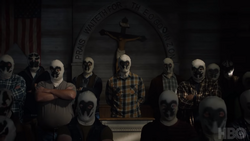The Seventh Kavalry was a white supremacist domestic terrorist organization based in Tulsa, Oklahoma.
Taking inspiration from the writings of the deceased vigilante Rorschach, the group's racially based crusade derives from its apathy towards the police force and the Robert Redford's administration, whom they deem traitorous for their apologetic disposition towards African-Americans and other minority groups within the United States.
Despite the Kavalry's adoption of Rorschach's identity, it is clear that the misinterpretation of his beliefs has been the catalyst for the group's inflammatory actions.
History[]
The group was originally active around 2015-2016. Before going underground, a purge, later known as the White Night, took place during which members of the Kavalry invaded hundreds of homes belonging to members of the police. Multiple police officers and their families were murdered, leading local law enforcement to begin donning masks in order to secure their identities. Senator Joe Keene Jr. introduced the Defense of Police Act, commonly referred to as DOPA, as an amendment to the Keene Act so police officers could wear masks which would protect their identities.

Seventh Kalvary Hideout
In 2019, the Kavalry's resurgence was initiated after one of the member, Carmichael shot and critically wounded Police Officer Charlie Sutton. After hearing of the incident, undercover police officer Sister Night arrested and detained a suspect living in the white ghetto Nixonville. Later, the Kavalry broadcast a video to the Tulsa Police Department, using Rorschach's rhetoric while threatening to kill more police. The suspect brought in by Night was first questioned by Looking Glass. Glass confirmed that the suspect knew where the Kavalry were. After Night's fatal interrogation of the suspect revealed the location of one of the Kavalry's bases, Chief Judd Crawford authorized a raid on their base: a cattle ranch. Inside the house, several Kavalry members, Carmichael included, were removing lithium batteries and placing them in buckets. When they spotted the police approaching them, they prepared to evacuate, each members carrying cyanide capsules. in a plane while two others manned an M2 Browning machine gun, killing several of their own cattle and police officers. Sister Night managed to kill the gunners before confronting Carmichael in the house. Before she could question him, however, he swallowed his cyanide capsule. The other members who fled in the plane were pursued by an owlship, piloted by Crawford and Pirate Jenny. They destroyed the plane with the owlship's flamethrower, though they crashed as a result.
Members[]
- Joe Keene (deceased)
- Mike (deceased)
- Renee
- Carmichael (deceased)
- The Suspect (deceased)
Appearances[]
- "It's Summer and We're Running Out of Ice"
- "Martial Feats of Comanche Horsemanship"
- "She Was Killed by Space Junk"
- "Little Fear of Lightning"
- "An Almost Religious Awe"
- "A God Walks into Abar"
- "See How They Fly"
Trivia[]
- The first episode of the Watchmen television series indicates that the name is spelled as "Kavalry", with Judd Crawford referring to the organization as "the 7K". Moreover, the MEMO: "Rorschach's Journal" document found on the Peteypedia section of the official HBO website mentions the Seventh Kavalry multiple times.[1]
- The Seventh Kavalry is named after the 7th Cavalry Regiment, an armored cavalry famous for its participation in some of the largest battles of the Indian Wars, including the infamous Battle of Little Bighorn, and was commanded by Lieutenant Colonel George Armstrong Custer.
- The 7th Cavalry Regiment was referenced in the original series. In Issue 11's supplemental material, Adrian Veidt gave an interview with Doug Roth for Nova Express in 1975, in which he views twentieth century society as a race between extinction and enlightenment. He compares the two concepts with both the Four Horsemen of the Apocalypse and the 7th Cavalry Regiment respectively. In the context of the interview, Veidt refers to the 7th Cavalry as making a noble, valiant, but futile last stand, believing their fight to be true and enlighten. Veidt, believing himself to be a true enlightened being who believed that the forces of extinction were likely going to win out, formulated his master plan to make his own stand against nuclear annihilation. Given the context, however, Veidt knew very well that his actions, much like the 7th Cavalry's, are not so honorable and that he would represent an apocalypse to the people of New York City, in the same way George Armstrong Custer represented an apocalypse to the Native Americans that he slaughtered, however, Veidt still believed that his actions were necessary in order to save humanity. In the HBO series, it's clear that Veidt's actions are both directly and indirectly responsible for the creation of the Seventh Kavarly as well as several other grievances in the world at large, and that any attempts that Veidt had toward creating his utopia were both futile and foolhardy much in the way of Custer's Last Stand.

